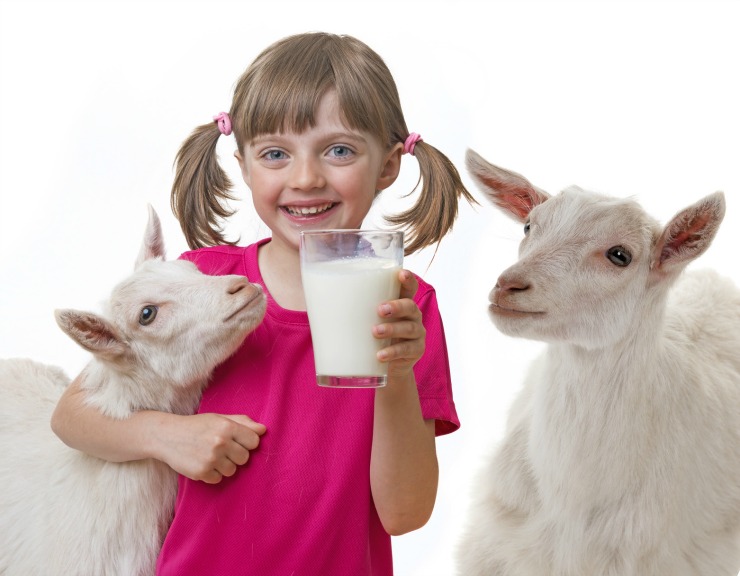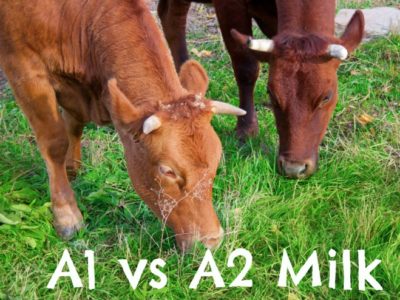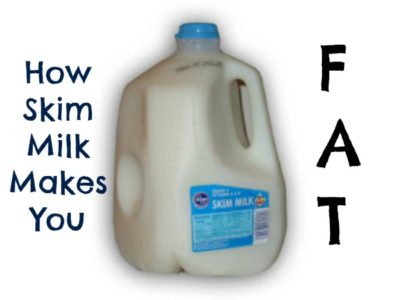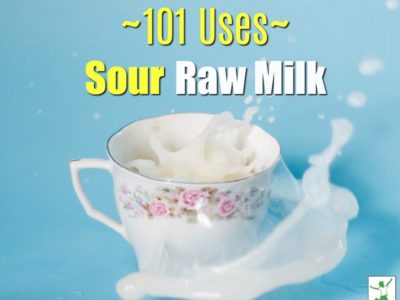Table of Contents[Hide][Show]

Goat milk, particularly raw goat milk, is becoming an increasingly popular alternative for people who wish to avoid processed supermarket milk. One of the reasons is ease of access. Anyone with a large backyard can easily house and milk a couple of goats supplying both their family and a few others with its delicious, creamy goodness. I myself have been toying for a long time with the idea of getting a couple of miniature goats. Several other friends of mine have already taken the plunge with varying results. Some love it, some don’t. But, you never know whether you will be one of the ones to love it until you try, right?
Cows, on the other hand, require much more land for grazing and to keep in general. In addition, allergies to cows milk have been on the increase in recent decades with goat milk the logical and typically easiest to obtain dairy alternative.
If you like to drink your milk raw like we do, keeping goats for milk is also a very good way to circumvent any laws against raw milk access that may exist in your state or province. Raw goat milk conveniently available in my own backyard has been my Plan B for many years should my state go off the deep end and suddenly disallow access to this nutrient rich food that is essential for raising healthy, sturdy children free from allergies and other health ailments or behavior problems.
Benefits of Raw Goat Milk
Goat Milk vs Cow Milk
Cow milk and goat milk differ in several significant ways. The most obvious difference is the creamline. Raw goat milk has virtually none as it is naturally homogenized. This means the fat molecules are smaller and suspend within the liquid portion of the milk evenly and much more readily than those of cow milk. Cow milk has a distinctive creamline on top when in a raw state and particularly if it is grassfed. This requires the consumer to shake the container to mix the cream with the liquid portion of the milk before pouring a glass. This is not required with raw goat milk.
Fat in Goat Milk
This smaller size of the fat molecules in goat milk seem to make it easier to digest for some people, but not all. Others find cow milk easier to digest and still others detect no digestive differences whatsoever. I personally fall in the latter camp.
Another visual difference between cow milk and goat milk is the color. Properly raised goats and cows that are free to graze and forage produce strikingly different looking milk. Grassfed cows milk has a distinctively beige colored appearance whereas pastured goat milk is nearly pure white. Why the difference? I honestly do not know. I have asked numerous farmers and raw milk experts this question but have yet to receive an answer. Perhaps the difference has to do with the different levels of nutrients present in each which is discussed further below.
Protein in Goat Milk
In addition to differences in the fat structure, goat milk also differs from cow milk in the protein structure.
While the protein structure of cow and goat milk is fairly similar, goat milk is missing an alpha casein present in cow’s milk. This makes it an A2 milk regardless of breed for those of you familiar with the term. Cow milk may be A1 or A2 milk depending on genetics. Early research suggests that A2 milk is easier to digest than A1 milk, hence those who seek exclusively A2 milk typically find goat milk to be a logical choice.
Like fat, the protein curds in goat milk are smaller in size and softer than those formed by cow milk. Thus, when you drink a glass of goat milk and it reacts with the acid in your stomach, these smaller, softer curds that precipitate during the digestive process may be more readily tolerated. This is another reason some folks find goat milk to be easier on the digestion than cow milk.
Goat Milk Nutrition
Because it is a dairy food, goat milk is very similar in nutrition to other types of dairy milk. However, there are some significant and important differences for consumers who seek raw goat milk to be aware of.
First, goat milk is quite low in B12 and folate is completely absent. It is also lower in B6 than cow milk. Incidentally, B6 is destroyed by pasteurization so any sort of heat treated or pasteurized milk will be missing this nutrient. B6 is very helpful in the prevention of morning sickness for some women. The milk must be farm fresh and preferably grassfed to contain any B6 whatsoever.
Hence, while goat milk and particularly raw goat milk are easier to digest than cow milk for many people, critical nutrients are lower. Using raw goat milk for homemade baby formula must thus take care to add these nutrients in via small amounts of desiccated beef liver or cooked, pureed chicken liver to ensure baby is getting adequate nutrition as similar to human breastmilk as possible.
Raw Goat Milk Better than Pasteurized
It is important for consumers seeking the benefits of goat milk to take the trouble to source it raw instead of pasteurized. Pasteurization destroys much of the nutrition in goat milk including half or more of the vitamin C as well as all the probiotics and enzymes which are necessary for optimal absorption. One of the critical enzymes destroyed by pasteurization is phosphatase, which is essential for absorption of the calcium in goat milk.
Hence, drinking pasteurized goat milk loaded with calcium is ironically not going to help much with ailments like osteoporosis. Only raw goat milk will be of any benefit.
Raw goat milk is also much less likely to be allergenic than pasteurized. Hence, if a person suffers from a cow milk allergy, seeking goat milk in pasteurized form is likely to not make much difference. However, drinking raw goat milk may be very well tolerated.
Skip the Goat Milk Powder
One trend that seems to be catching on is the marketing of goat milk powder in cannisters and air-sealed bags. Note that dehydration of goat milk into a powder is not a healthy food to consume on a regular basis. In fact, it is even worse than pasteurization. Powderizing the whey in any dairy milk damages the delicate protein structures and makes the product much less digestible – even allergenic.
Powderizing goat milk into powder also oxidizes the cholesterol in the milk. While natural cholesterol is healthy, oxidized cholesterol contributes to inflammatory conditions and should be avoided. This is an example of how a healthy food like goat milk can be made unhealthy simply by the factory processing employed.
Goat milk powder is certainly no substitute for raw goat milk in homemade baby formula.
Raw Goat Milk Dangers
Like any food, raw goat milk can potentially harbor food borne pathogens. However, when it comes from healthy goats that are milked in a clean environment with hands-free technology and refrigeration methods employed, the risks are tiny compared with other foods. CDC data confirms these minuscule risks for raw goat milk.
It is up to the consumer to be aware of the milking and feeding methods employed by the farms they choose to support. Cleanliness in the milking parlor, unsprayed, well maintained pastures, and regular testing are signs that a farmer is doing everything within reason to ensure a safe and nutritious product for his/her customers.
Sarah, The Healthy Home Economist









Mt Capra uses Refrance Window Drying Technology, which said to be “the gentlest method to dry fresh whole foods. It is a unique, self-limiting dehydration method that uses infra-red light, rather than direct extremes of temperature, to remove water from food. Relying on the conductivity of water together with the properties of infra red and the refractance of light, this is the preferred method for preserving the precious nutrients and phytonutrients found in whole foods. In this process, important sensory qualities of the fresh whole food, such as color, aroma, taste and nutritional value are retained. This is an indicator that the active aromatic and pigment compounds which impart sensory and nutritionally invaluable properties have been preserved throughout the drying process. Studies have shown foods dried by Refractance Window® Drying Technology have a higher retention of vitamins, minerals, enzymes and antioxidants compared to those dried by more commonly practiced methods such as spray or freeze drying. Mt. Capra is proud to have been the very first company ever, to offer whole food products which have been dried using this advanced, yet gentle, technology” (MtCapra). It seriously doesn’t go through high-temperature treatment which kills off enzymes (check the website!). Is this okay?
Good info, but powdering milk proteins still denatures them. Sorry!
Thank you for making your raw goat information available to me, Sarah.
We have very similar health concerns, and I am looking forward to receiving your newsletter!
Like you, I am considering obtaining ownership of a couple of goats – Nubians.
You look Great, and your face resembles mine so much that you look like my sister!